Premade stock may win in convenience, but homemade seafood stock is well worth the effort. It’s richer in flavor, and only takes 30 minutes! Plus you make it with leftover scraps, which saves money and reduces food waste. This easy recipe teaches you how to make homemade fish stock—no special equipment necessary.

Don’t throw away fish heads, bones, and shrimp shells! Instead, keep a freezer bag to fill with scraps—or ask your nearest fishmonger—and make this flavorful, easy, and delicious seafood stock recipe.
I have been making homemade stock for years. Unfortunately, I don’t have time to make a batch every week, and I’ll admit I still use plenty of store-bought stock. But whenever I cook with homemade, the difference in flavor is enough to get me thinking about the next weekend afternoon I can dedicate to building up a stash.
The trick is to collect odds and ends in your freezer so when you have a little time to spare you have what you need to make stock. Just combine those seafood scraps with a few fresh aromatics and let them simmer into a flavorful broth. I keep a freezer bag of vegetable scraps to make Vegetable Broth, another for chicken to simmer for Chicken Stock, and one for fish and shellfish to make fish stock.
Most often, I focus on vegetable stock, as it’s the most versatile and the freezer bag that fills the fastest. But the difference homemade seafood stock makes in some of my favorite meals, like Seafood Paella, bolstered me to take the plunge, especially after realizing fish stock simmers for just 30 minutes.
Table of Contents
- Ingredients for Seafood Stock
- How to Make Seafood Stock
- The Best Fish and Seafood to Use for Seafood Stock
- What Fish to Avoid When Making Seafood Stock
- The Best Vegetables and Aromatics for Seafood Stock
- Where to Buy Seafood for Stock
- Saving and Freezing Scraps to Use in Stock
- What to Serve with Seafood Stock
- Use Your Homemade Seafood Stock in These Recipes!
- Seafood Stock Recipe

Ingredients for Seafood Stock
The basis of a good seafood stock or seafood broth as it’s also called is fish bones and crustacean shells plus support from aromatic vegetables to round out the flavor. And, because you control which ingredients you add, you can adjust the flavor as you want. For example, depending on how I plan to use it, sometimes I want more shellfish than fish or I want to use fennel instead of leek. Here is a good place to start, and you can tweak your recipe from there:
- Fish bones and heads: For the most flavor and body, use uncooked bones and heads from white-fleshed salt-water fish.
- Crustacean shells: I like to include at least 1 cup of shells, heads, and tails from shrimp, lobster, or crab for their rich, briny flavor.
- Aromatic vegetables: I like to use a classic combination of onion, leek, carrot, and celery. Because of the short cooking time, dice them small to extract the most flavor.
- Flat leaf parsley: I include a small handful, using both the stems and leaves.
- Bay leaf: Adds floral complexity. You might not notice its subtle flavor, but if you skip it, it will taste like something’s missing.
- White peppercorns: White pepper is milder than black pepper, with a grassy flavor that lets the seafood flavor shine through. You can substitute an equal amount of black peppercorns if that’s what you have on hand.
How to Make Seafood Stock
It may seem advanced, but making homemade seafood stock only requires throwing everything in a pot, covering it with cool water, and simmering it on the stove for 30 minutes. Here’s how to make it:
- Gather the ingredients: Into a large stockpot, add about 2 pounds of fish scraps like bones, heads, tails and 1 cup crustacean shells. Next, add 1 each finely chopped onion, leek, carrot, and celery. A small bunch of parsley, 1 bay leaf, and about 10 white peppercorns. Pour enough cold water to cover the ingredients, about 10 cups.
- Simmer the stock: Set the pot over medium-high heat and bring it to a simmer. Reduce the heat to medium-low and cook for 30 minutes. Adjust the heat as needed to maintain a gentle simmer.
- Skim the stock: While the stock simmers, use a spoon to skim off any foam that forms on the surface.
- Strain the stock: Use a spider or tongs to remove most of the solids from the stock. Set a mesh strainer lined with cheesecloth in a large bowl or pot. Pour the stock through the strainer. Press the solids to release any additional liquid. You should have about 8 cups of stock.
- Store: Pour the stock into jars. Let the stock cool completely, then store them in the fridge or freezer. The stock will keep in the refrigerator for up to 5 days, or in the freezer for up to 3 months. Leave extra room in the containers for the liquid to expand if freezing.
The Best Fish and Seafood to Use for Seafood Stock
The type of fish and seafood you use in your homemade stock will make a big difference in the flavor of the stock. I’ve made the best-tasting stock using these options:
- White-fleshed, salt-water fish: use the heads, spines, ribs, and tails of white fish such as snapper, bass, cod, tilapia, or hake.
- Flatfish: use the bones from flat fish such as turbot, halibut, or sole.
- Shellfish: use the heads, tails, and shells of shrimp, prawn, lobster, or crab.
What Fish to Avoid When Making Seafood Stock
Oily and fish fatty fish like salmon, tuna, mackerel, or sardines are not ideal for making homemade seafood stock. Although they make a delectable dinner, they will likely leave cloudy impurities, off flavors, or an overly fishy taste.
The Best Vegetables and Aromatics for Seafood Stock
The classic aromatics for seafood stock are onion, leek, celery, and carrots. That said, you can also add other aromatic vegetables and herbs such as garlic, fennel, tomato, tarragon, and/or thyme.
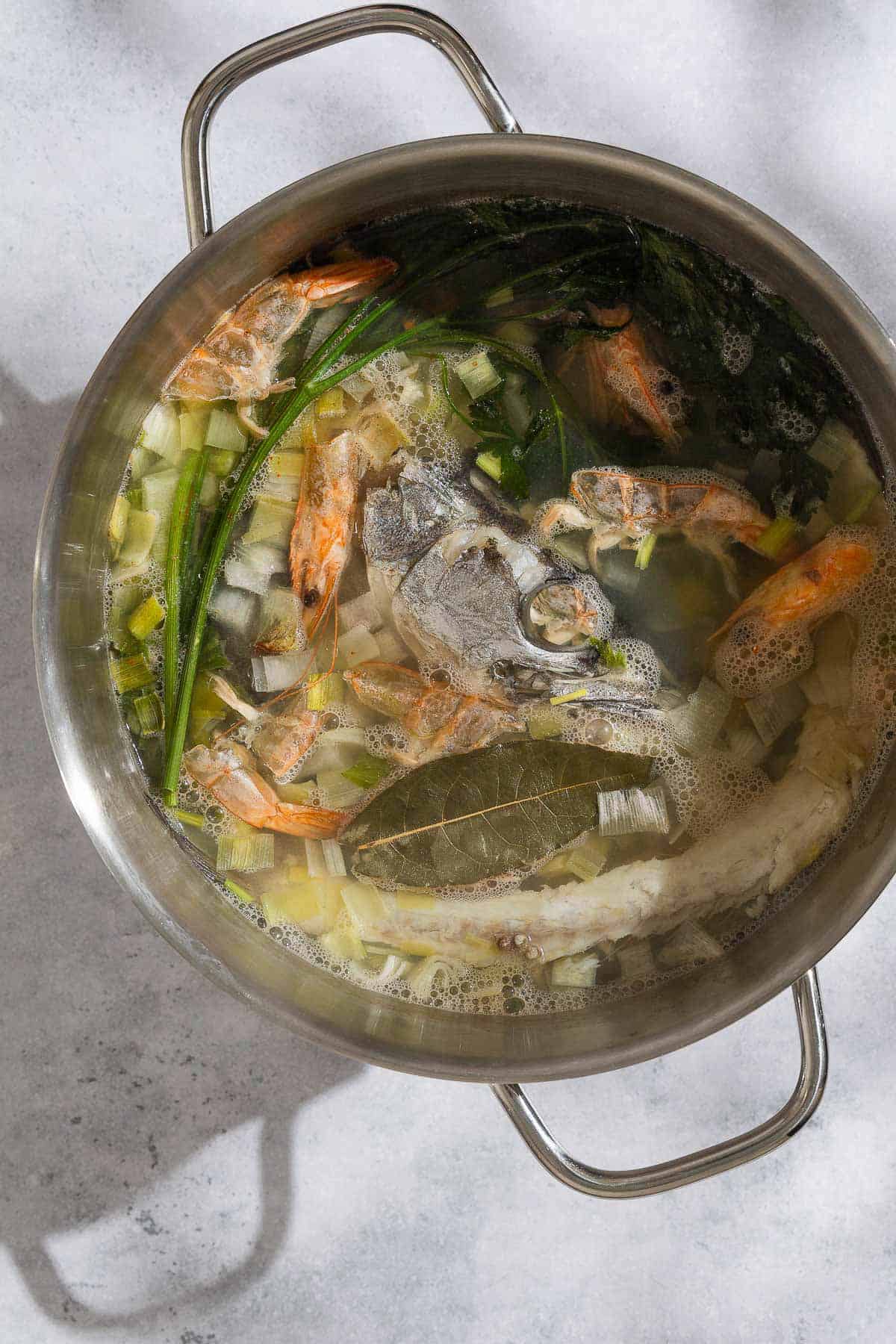
Where to Buy Seafood for Stock
There’s no need to buy expensive seafood to make fish stock! Some grocery stores and most dedicated fishmongers will happily sell–or even gift–what you need to make homemade seafood stock.
I often head to the market the day before or early in the morning the day of making stock and ask them to save scraps I can come back to pick up later. Whenever I’ve asked to pay, they’ve always happily given it away.
Additionally, you can save bones and shells in the freezer whenever you prepare seafood at home.
Saving and Freezing Scraps to Use in Stock
I keep goody bags in my freezer of seemingly useless food scraps, including one for fish and seafood. If you filet fish at home, save the bones, head, and tail in the freezer until you have enough to make stock.
You can also save shells, bones, heads, and tails that have already been cooked from shrimp, lobster, or Roasted Whole Fish. If they’re already cooked, they won’t be as potent, but they’re still worth saving and using.

What to Serve with Seafood Stock
I use homemade seafood stock in any recipe that calls for seafood stock, or in some fish recipes that call for chicken or vegetable stock to give it an extra vibrant seaside flavor.
Seafood pasta or rice dishes that soak up the stock are particularly delicious, like Fideuà or Shrimp Risotto. It also makes for an aromatic base for soups and stews, like Italian-American Cioppino or Mediterranean-style fish Soup.
I also like to use a mix of seafood stock and white wine to steam Mussels and Clams. It’s great for deglazing as well, and for making a flavorful pan sauce after searing fish or shellfish, like in this recipe for Garlic Shrimp with Bell Peppers.
Use Your Homemade Seafood Stock in These Recipes!
Browse all Mediterranean recipes.
Visit Our Shop.
Seafood Stock
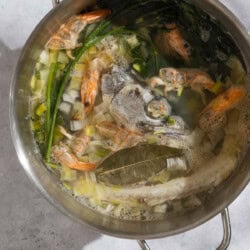
Ingredients
- 2 pounds fish bones and heads (see note)
- 1 cup raw crustacean shells (crabs, lobsters, shrimp, and/or crayfish)
- 1 yellow onion, finely chopped
- 1 leek, finely chopped
- 1 carrot, finely chopped
- 1 celery stick, finely chopped
- 1 small bunch fresh flat-leaf parsley, both stems and leaves
- 1 bay leaf
- 1 teaspoon white peppercorns
- 10 cups cold water
Instructions
- Gather the ingredients: Into a large stockpot, add the fish bones, crustacean shells, onion, leek, carrot, celery, parsley, bay leaf, and white peppercorns. Pour enough cold water to cover the ingredients (about 10 cups for a single batch).
- Simmer the stock: Set the pot over medium-high heat and bring it to a simmer. Reduce the heat to medium-low and cook for 30 minutes. Adjust the heat as needed to maintain a gentle simmer.
- Skim the stock: While the stock simmers, use a spoon to skim off any foam that forms on the surface.
- Strain the stock: Use a spider or tongs to remove most of the solids from the stock. Set a mesh strainer lined with cheesecloth in a large bowl or large pot. Pour the stock through the strainer. Press the solids to release any additional liquid. You should have about 8 cups of stock.
- Store: Pour the stock into jars, leaving an inch at the top to allow for expansion. Let the stock cool completely, then store them in the fridge or freezer. The stock will keep in the refrigerator for up to 5 days, or in the freezer for up to 3 months.
Notes
- Visit our shop to browse quality Mediterranean ingredients including olive oils, honey, jams, and spices.
- For the most flavor and body, use uncooked bones and heads from white-fleshed salt-water fish. That said, if you have bones and shells that are already cooked, they won’t be as potent but they’re still worth saving and using.
- Avoid: Oily fish and fatty fish like salmon, tuna, mackerel, or sardines will impart too strong of a flavor.
- Other aromatic ideas: Garlic, fennel, tomato, tarragon, and/or thyme.
- Nutrition facts are given per ounce.
Nutrition

Stock Your Pantry with the Best
Our Simply Dinner Pantry Essentials kit with 9 vibrant pantry staples to begin your journey cooking the Mediterranean Way.



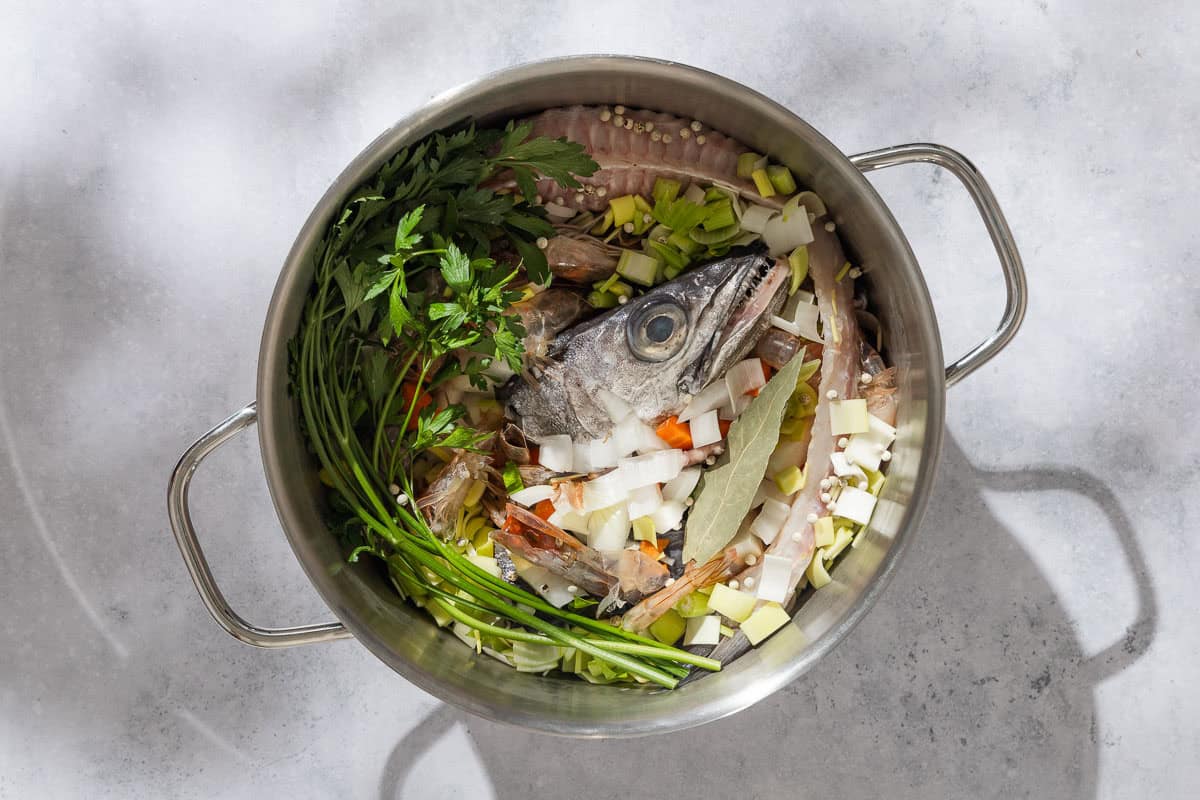
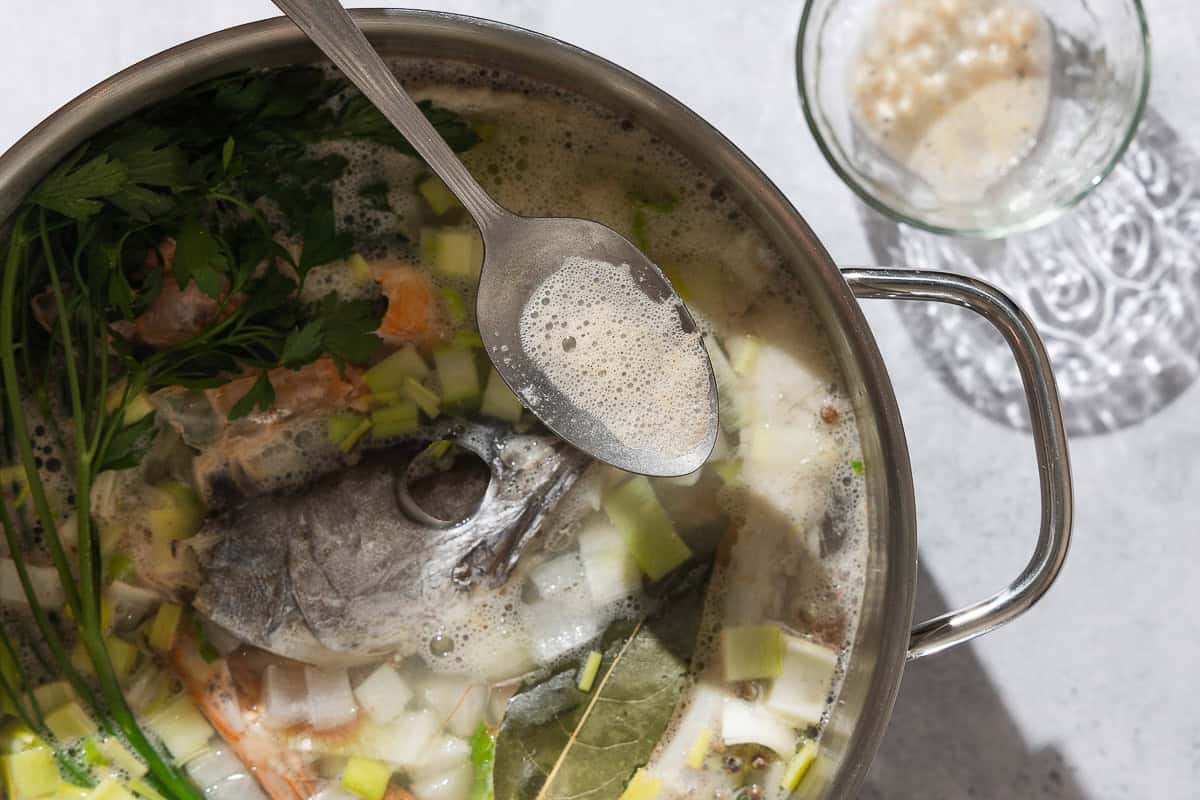

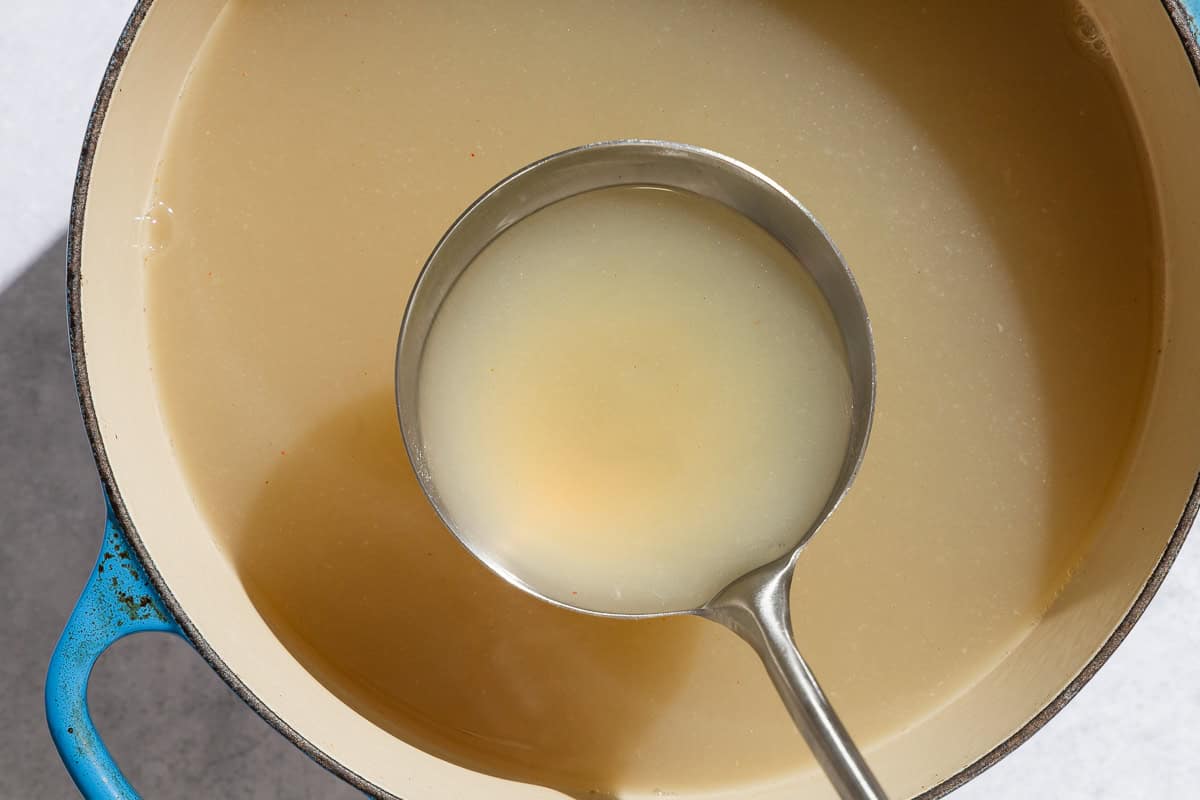




How about canning this? Is it possible?
I’d love to make this to have on hand. Hwever, I don’t think I would use all that much, but I’d like to make it and can it.
(Sorry, I can’t correct with the format you have…..so mistakes stay)